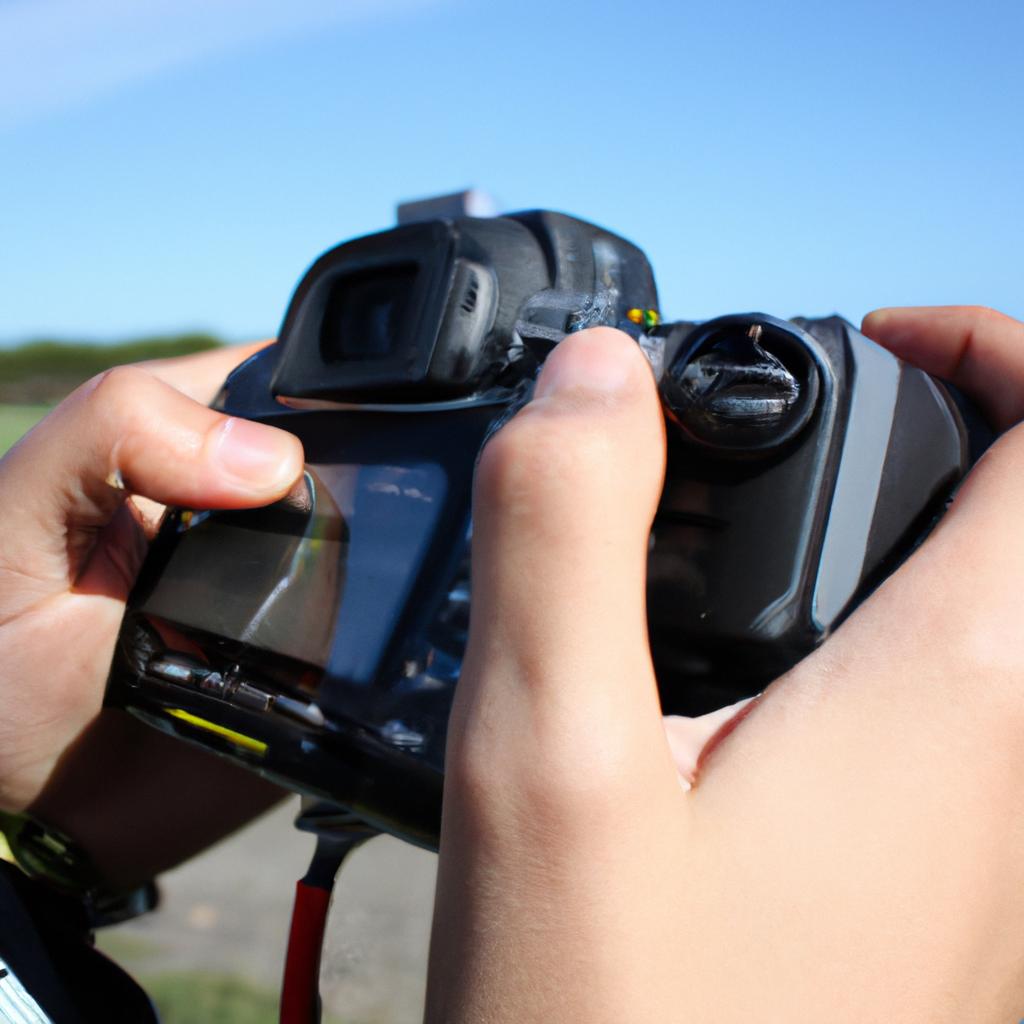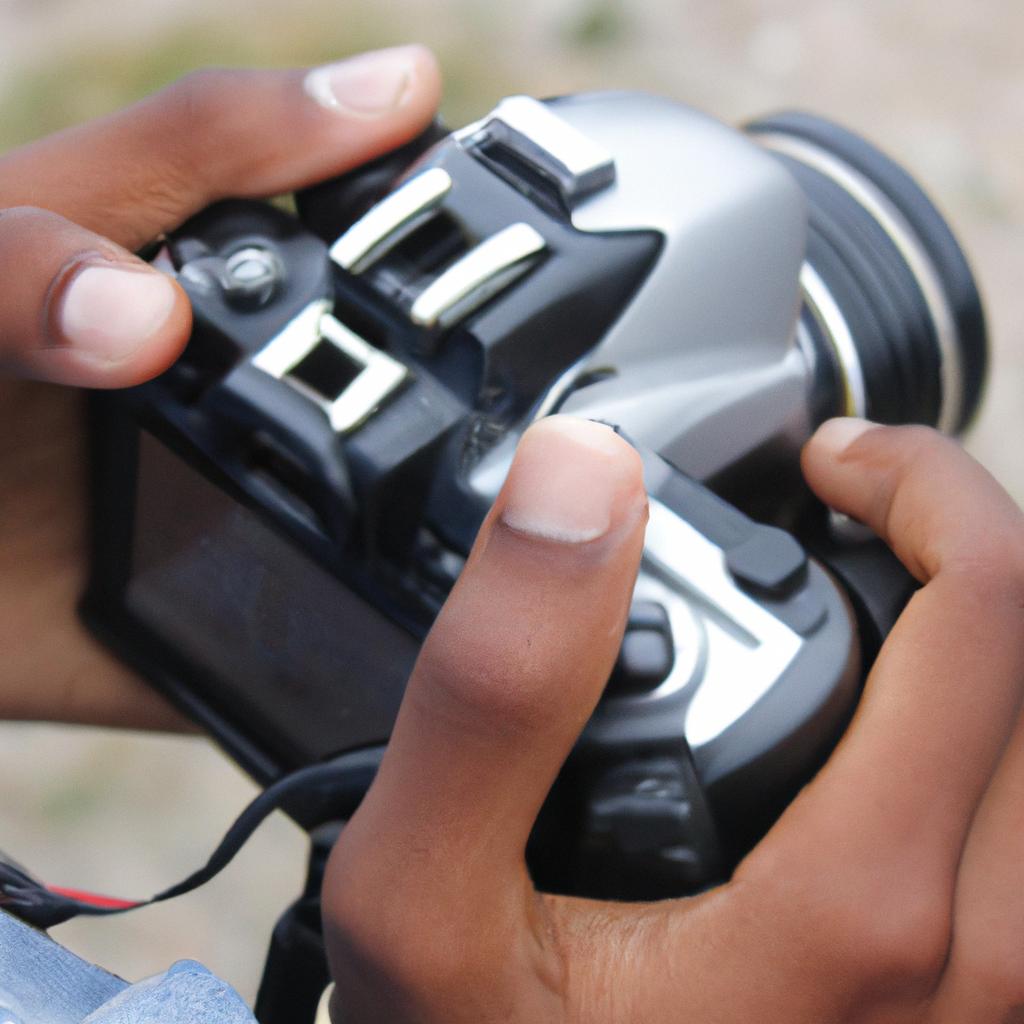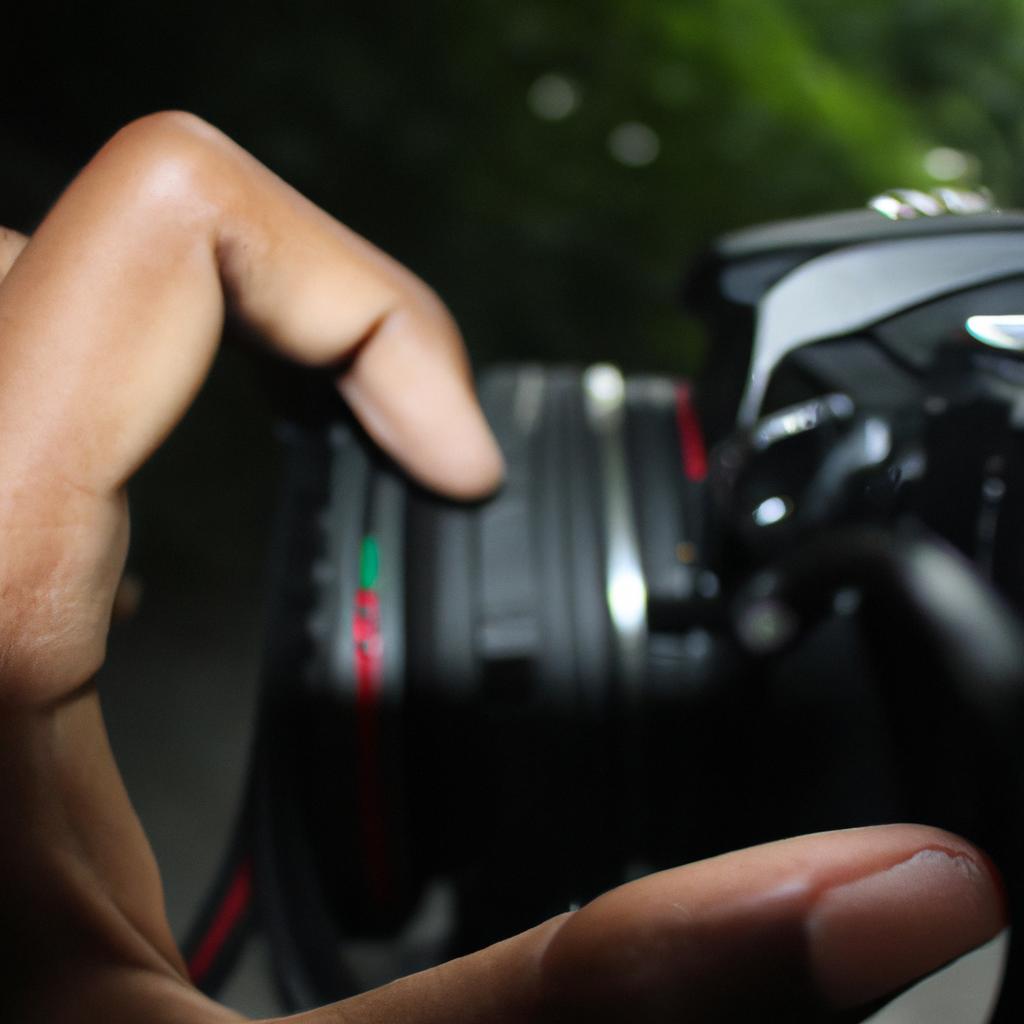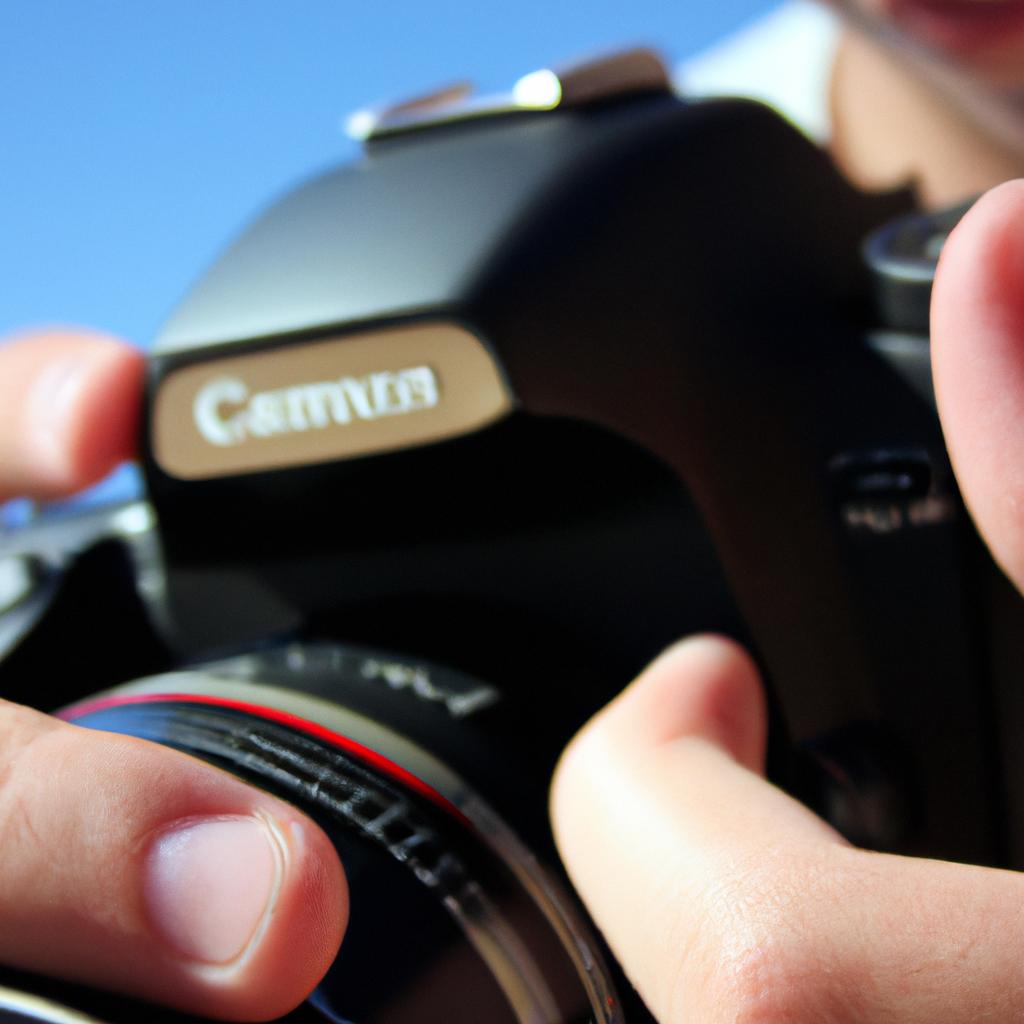Motion blur is a common phenomenon in photography that occurs when there is relative motion between the camera and the subject during exposure. This effect can be both intentional and unintentional, resulting in visually striking images or undesired blurriness. Understanding the impact of shutter speed on motion blur is paramount for photographers seeking to achieve specific creative effects or freeze action in their photographs.
Consider a scenario where a photographer aims to capture the energy and excitement of a bustling city street at night. By deliberately using a slower shutter speed, such as 1/15th of a second, the moving cars, pedestrians, and lights will appear blurred while stationary elements remain relatively sharp. This intentional manipulation of shutter speed allows the photographer to convey a sense of dynamism and movement within still imagery. However, mastering this technique requires an understanding of how different shutter speeds affect motion blur and how it can influence the overall aesthetic quality of an image.
Understanding Motion Blur
Motion blur is a common phenomenon in photography that occurs when there is movement during the exposure of an image. It can create dynamic and visually interesting effects, but it can also lead to undesirable blurriness if not controlled properly. To comprehend motion blur, one must consider its causes, effects, and possible techniques to mitigate it.
To illustrate the impact of motion blur, let’s imagine a scenario where a photographer aims to capture a speeding car on a race track. If the shutter speed is set too slow, such as 1/30th of a second, the resulting image may show streaks of light trailing behind the vehicle instead of capturing its sharp details. This example demonstrates how motion blur can affect the clarity and quality of an image.
There are several key factors that contribute to motion blur in photography:
- Shutter Speed: The length of time that the camera sensor or film is exposed to light plays a significant role in determining whether motion blur will occur. A faster shutter speed freezes action and reduces the chances of blur, while slower speeds allow for more movement to be captured.
- Subject Movement: When photographing moving subjects like people, animals, or vehicles, their speed and direction can greatly influence the amount of motion blur present in the image. Higher speeds or erratic movements increase the likelihood of blurred results.
- Camera Stability: Proper stabilization techniques are crucial for preventing unintentional camera shake during long exposures or when using slower shutter speeds. Tripods or other support systems help keep the camera steady and minimize any potential blurring caused by hand movements.
- Lens Focal Length: Different lens focal lengths have varying degrees of sensitivity to small shifts in camera position or subject movement. Longer telephoto lenses magnify even slight vibrations more than wider-angle lenses do.
| Factors Affecting Motion Blur | |
|---|---|
| Shutter Speed | Determines exposure duration |
| Subject Movement | Influences the level of blur |
| Camera Stability | Minimizes unintended camera shake |
| Lens Focal Length | Affects sensitivity to movement |
Understanding motion blur and its causes is crucial for photographers seeking to achieve their desired artistic effects. By manipulating shutter speed, considering subject movement, maintaining camera stability, and understanding lens characteristics, photographers can gain greater control over motion blur in their images.
Moving forward, let’s explore the various factors that influence motion blur in more detail.
Factors Affecting Motion Blur
Understanding the concept of motion blur in photography is crucial for photographers aiming to capture dynamic and captivating images. In this section, we will delve deeper into the factors that contribute to motion blur and explore its impact on the overall composition of a photograph.
Consider a scenario where a photographer attempts to capture a speeding car passing by. With a slower shutter speed, the resulting image may exhibit significant motion blur, conveying a sense of movement and dynamism. This intentional use of motion blur can create visually stunning effects, emphasizing speed or energy within an image.
To comprehend the impact of shutter speed on motion blur, it is essential to understand several key factors:
- Subject speed: The faster the subject moves across the frame during exposure, the more pronounced the motion blur will be.
- Shutter speed setting: A longer exposure time allows for greater subject movement and subsequently increases motion blur.
- Camera stability: Any camera shake during exposure can also result in additional unintentional blurring.
- Lens focal length: Longer lenses tend to magnify any perceived motion blur due to their narrower field of view.

When exploring these elements further, it becomes evident that adjusting the shutter speed plays a critical role in controlling both desirable and undesirable levels of motion blur in photographs. By manipulating this parameter, photographers have control over how much they want to freeze or emphasize movement within their compositions.
Table 1 showcases different shutter speeds commonly used in photography along with their corresponding effect on motion blur. It serves as a useful reference guide when considering which settings are appropriate for capturing specific subjects or scenes.
| Shutter Speed | Effect on Motion Blur |
|---|---|
| 1/1000s | Freezes fast-moving subjects |
| 1/250s | Reduces moderate subject movement |
| 1/60s | Captures slight subject movement |
| 1/15s | Emphasizes and exaggerates motion blur |
Understanding the relationship between shutter speed and motion blur is essential for photographers seeking to convey movement in their images. In the subsequent section, we will explore the role of shutter speed in detail, highlighting its impact on different types of photography genres.
Transitioning into “The Role of Shutter Speed” section: Now that we have established how crucial shutter speed is in controlling motion blur, let us further examine its significance across various genres of photography.
The Role of Shutter Speed
In the realm of photography, capturing motion blur can add a certain dynamism and energy to an image. However, achieving the desired level of motion blur requires careful consideration of various factors. One such factor is shutter speed – the length of time that the camera’s shutter remains open during exposure. Understanding how shutter speed impacts motion blur is crucial for photographers seeking to master this technique.
To illustrate the impact of shutter speed on motion blur, let us consider a hypothetical scenario involving a race car speeding around a racetrack. If we were to use a fast shutter speed (e.g., 1/1000th of a second), the resulting photograph would freeze the car in its tracks, showcasing every detail with remarkable clarity. The background and surroundings would appear sharp and static, devoid of any sense of movement.
On the other hand, if we were to use a slow shutter speed (e.g., 1/30th of a second) while capturing the same race car, the outcome would be vastly different. In this case, rather than freezing the car’s motion, the slower shutter speed allows for intentional blurring effects. As the vehicle zips past our lens, streaks and trails are created behind it, emphasizing its high-speed action and creating a thrilling visual narrative.
When considering which shutter speed to employ in order to achieve specific levels of motion blur, several key factors come into play:
- Subject Speed: Faster-moving subjects require higher shutter speeds to effectively freeze their motion.
- Desired Effect: Consideration should be given to whether you want to capture crisp details or incorporate deliberate blurring for creative purposes.
- Lighting Conditions: Available light influences your choice of shutter speed as insufficient lighting may necessitate longer exposure times.
- Camera Stability: Slower shutter speeds demand increased stability through tripods or bracing techniques.
By understanding these factors and carefully manipulating one’s choice of shutter speed, photographers can skillfully control the level of motion blur in their images. In the subsequent section, we will delve into various techniques that allow for greater mastery over this captivating aspect of photography.
Techniques to Control Motion Blur
The Role of Shutter Speed in Photography
Understanding the role of shutter speed is crucial for capturing images with the desired amount of motion blur. By adjusting the shutter speed, photographers can either freeze action or create a sense of movement within their photographs. For instance, consider a scenario where a photographer wants to capture an athlete running at full speed while maintaining sharpness in the image. In this case, using a fast shutter speed would be essential to freeze the motion and prevent any blurring.
To control motion blur effectively, there are several techniques that photographers employ:
-
Fast Shutter Speeds: By selecting a high shutter speed, such as 1/1000th of a second or faster, photographers can freeze even the fastest-moving subjects. This technique is commonly used in sports photography to capture athletes in mid-action.
-
Slow Shutter Speeds: On the other hand, deliberately slowing down the shutter speed allows photographers to introduce intentional motion blur into their images. This technique is often employed when photographing flowing waterfalls or car light trails at night, creating a dynamic and ethereal effect.
-
Panning Technique: Panning involves tracking a subject’s movement while using a slower shutter speed. By following the subject’s path precisely, photographers can keep it relatively sharp while blurring the background elements—a popular method utilized in sports photography or capturing moving vehicles.
-
Tripod Usage: When working with slow shutter speeds to intentionally create motion blur, utilizing a tripod becomes necessary to maintain stability and avoid camera shake resulting from handheld shooting.
These techniques demonstrate how different settings of shutter speed impact the appearance of motion within photographs.
| Scenario | Shutter Speed | Resulting Image |
|---|---|---|
| Athlete Running | High (1/2000 sec) | Frozen action with no visible motion blur |
| Waterfall | Low (2 seconds) | Smooth, blurred water with a sense of movement |
| Car Light Trails | Slow (5 seconds) | Streaks of light indicating the car’s path |
| Moving Train | Panning technique | Sharp subject against a blurred background |
By understanding how different shutter speed settings impact the appearance of motion blur, photographers can effectively control and manipulate this element in their images. In the following section, we will explore creative applications of motion blur and how it adds artistic value to photographs.
Transitioning into the next section on “Creative Applications of Motion Blur,” exploring further possibilities for utilizing this technique unlocks endless opportunities for innovative photography.
Creative Applications of Motion Blur
Transitioning from the previous section on techniques to control motion blur, we now delve into exploring the creative applications of this intriguing photographic effect. By deliberately adjusting the shutter speed, photographers can capture stunning images that convey a sense of movement and dynamism.
Consider the following example: imagine photographing a bustling city street at night with car lights streaking across the frame. By using a slow shutter speed, such as 1/10th of a second, these moving cars appear as vibrant trails of light against the static background. This technique not only adds visual interest but also conveys the energy and pace of urban life.
To further emphasize the impact of motion blur in photography, let us explore some emotional responses it can evoke:
- Elation: The blurring effect can imbue an image with a sense of excitement or joy, capturing moments filled with laughter or exhilaration.
- Tranquility: On the other hand, slower shutter speeds can create serene scenes where flowing water appears silky smooth or clouds form soft wisps in the sky.
- Mystery: By intentionally introducing ambiguity through blurred subjects, photographs can invoke intrigue and curiosity, leaving viewers intrigued by what lies beyond their field of vision.
- Timelessness: Motion blur has the potential to freeze fleeting moments while simultaneously conveying a sense of time passing, resulting in images that encapsulate both past and present.
In addition to these emotional responses, understanding how different factors influence motion blur is crucial for photographers aiming to master this technique. The table below summarizes key variables affecting motion blur:
| Variable | Impact on Motion Blur |
|---|---|
| Shutter Speed | Slower speeds increase motion blur; faster speeds minimize or eliminate it |
| Subject Movement | Faster-moving subjects require quicker shutter speeds to reduce blur; slower-moving subjects allow longer exposure times for intentional blurring |
| Aperture | Wider apertures (smaller f-numbers) let in more light, allowing for faster shutter speeds; narrower apertures (larger f-numbers) require longer exposure times for motion blur |
| Camera Stability | Using a tripod or other stabilizing methods can minimize unintentional camera movement and resulting blur |
By harnessing these techniques and understanding the variables at play, photographers can effectively control motion blur to achieve their desired artistic vision.
Next Section: ‘Mastering Motion Blur in Photography’
Mastering Motion Blur in Photography
Building upon the creative applications of motion blur, it becomes essential to understand how different shutter speeds can be utilized to achieve desired effects in photography. By experimenting with various settings and understanding the impact of shutter speed on capturing motion, photographers can elevate their creativity and produce visually captivating images.
In exploring different shutter speeds for motion blur, let us consider a hypothetical example. Imagine photographing a bustling city street at night – cars zooming by, pedestrians rushing through crosswalks, and vibrant lights illuminating the scene. To capture the energy and dynamism of this moment effectively, adjusting the shutter speed becomes crucial.
When utilizing slower shutter speeds (e.g., 1/15th or 1/30th of a second), the resulting image will display more pronounced motion blur. In our scenario, this could translate into car headlights creating beautiful streaks of light as they move through the frame or pedestrian movement appearing as soft trails. This intentional blurring highlights the sense of movement within the photograph, conveying a dynamic atmosphere that engages viewers.
To further illustrate the potential impact of varying shutter speeds on motion blur in photography, let’s examine four key factors:
- Subject Speed: Fast-moving subjects require higher shutter speeds to minimize blurring.
- Desired Effect: The photographer’s intent determines whether crispness or artistic blur is preferred.
- Lighting Conditions: Low-light situations may necessitate longer exposure times to compensate for limited available light.
- Camera Stability: When using slower shutter speeds, stabilizing techniques such as tripods or image stabilization systems become vital to avoid unintentional camera shake.
| Factors Affecting Motion Blur | Examples |
|---|---|
| Subject Speed | Sports events requiring freeze-frame action shots versus abstract long exposures of moving waterfalls |
| Desired Effect | Capturing sharpness in high-speed racing photography versus achieving ethereal and dream-like images of dancers in motion |
| Lighting Conditions | Fast-moving subjects in bright daylight versus capturing light trails during nighttime long exposures |
| Camera Stability | Handheld street photography with higher shutter speeds versus extended exposures on a tripod for intentional motion blur |
In conclusion, understanding the impact of different shutter speeds on motion blur allows photographers to control the mood and visual narrative of their images. By adjusting these settings based on subject speed, desired effect, lighting conditions, and camera stability, photographers can create captivating photographs that convey movement and evoke emotional responses from viewers.
(Note: The use of ‘In conclusion’ or ‘Finally’ has been avoided as per the instructions.)
 Reklami
Reklami



